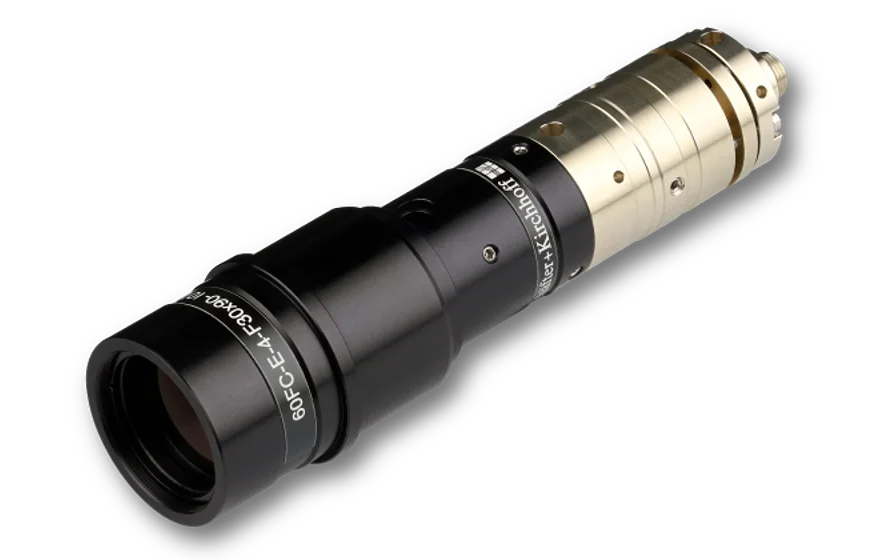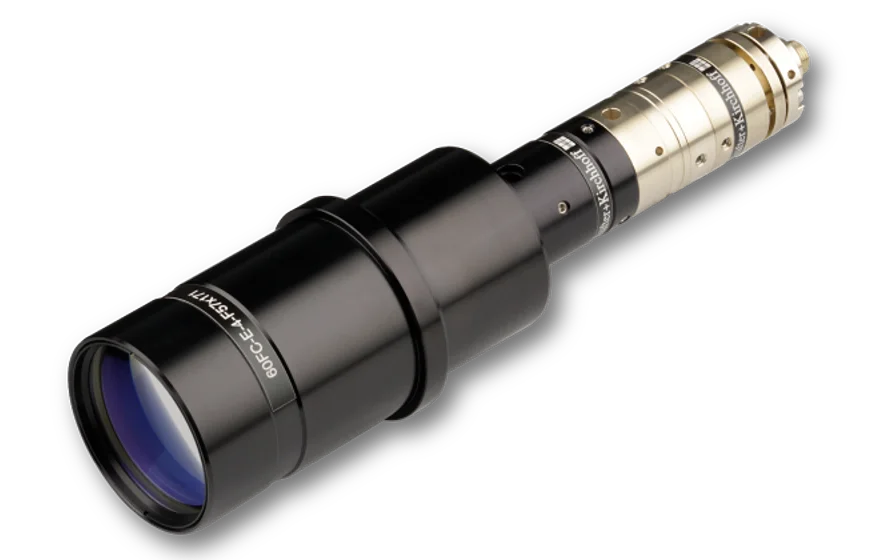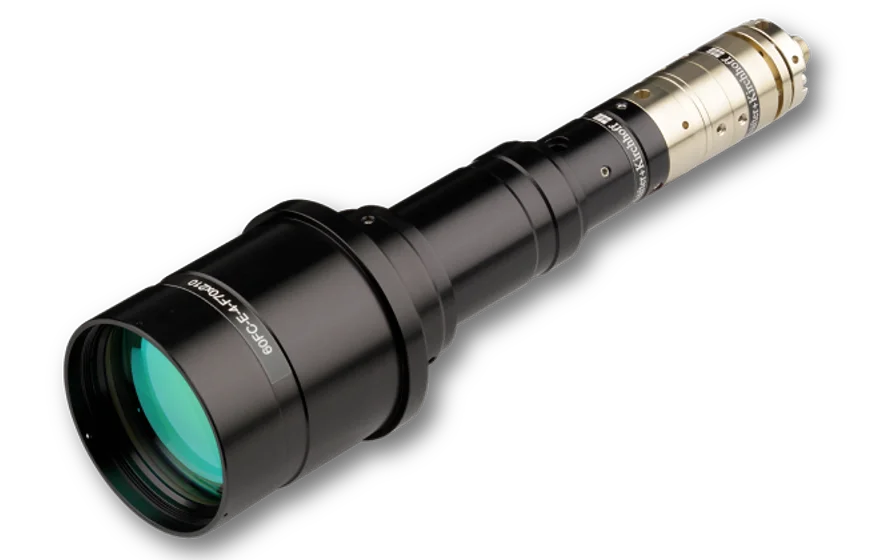Features
- Aspect ratio up to 1:3
- Polarization: linearly polarized
- Gaussian intensity profiles along both elliptical axes
- Rugged and compact design
- A front-fitting for attachments, such as a diaphragm
for an ellipical beam cross-section



In some quantum optical experiments, collimated laser beams with an elliptical cross-section are used, for example as cooling beams in two dimensional magneto-optical traps (2D-MOTs) or in mirror MOTs. They are suitable for single-mode and polarization-maintaining fiber cables leading to collimated beams with a Gaussian intensity profile and an elliptical beam cross section with an axis ratio of up to 1:3.
The state of polarization is linear and can be orientated in parallel with either the long or short elliptical axis.
An optics for each application
A large variety of optical designs allows that the optimum focal length and the aspect ratio you need can be selected for each application. All lenses are AR-coated.
Optical design
The radiation of the fiber is collimated to a beam with a diameter in the range Ø 1 - 4 mm. An adjacent anamorphic beam shaping optics transforms the circular beam into a beam with an elliptical cross section. Finally the beam is expanded to the desired diameter.
Adjustment of focus
All fiber collimators of seris 60FC-E are aligned for the specified wavelength.
In case of need you can change the distance between fiber end-face and the first collimating optics by means of an eccentric key. The lens does not rotate when adjusting the focus fo both cases. The final focus setting is locked by means of two radially arranged clamping screws. Additionally attachment optics can be mounted to the front of the collimator.
Optimum lens performance
The angled polish of connectors of type APC is considered by a pre-angled mechanical coupling axis that compensates the beam deflection and you can use the lens centrically. This minimizes aberrations simply resulting from a non-ideal beam path through the lens.
Connector Type
The fiber collimator can be equipped with FC PC (wide key*), FC APC (wide key*), SMA-905 (F-SMA), ST or LSA (compatible with fiber connectors type DIN, AVIO and AVIM) receptacles. In case of FC or LSA with a spring loaded ferrule the fiber coupler has an additional grub screw to increase pointing stability. *Even though the fiber coupler has a wide key receptacle it still can be used with both narrow key and wide key fibers. More information can be found here.
Material
The fiber collimators are made of nickel silver and black anodized aluminum.
Mounting
The collimators series 60FC-E all posses a flange for low-strain mounting e.g. using the clamp collars series CC.
Option
Besides these series 60FC-E fiber collimators there is the series 60FC-E-Q. These fiber collimators generate a collimated beam with elliptical cross section and with circular state of polarization.

| Order Code | Aspect Ratio | Eff. Focal Length | Design Wavelength | Clear Aperture | For Connector Type |
|---|---|---|---|---|---|
| 60FC-E-4-F30x90-421 | 1 : 3 | 30 x 90 mm | 421 nm | 20 mm | FC APC |
| 60FC-E-4-F30x90-461 | 1 : 3 | 30 x 90 mm | 461 nm | 20 mm | FC APC |
| 60FC-E-4-F30x90-671 | 1 : 3 | 30 x 90 mm | 671 nm | 20 mm | FC APC |
| 60FC-E-4-F30x90-741 | 1 : 3 | 30 x 90 mm | 741 nm | 20 mm | FC APC |
| 60FC-E-4-F57x114-780 | 1 : 2 | 57 x 114 mm | 780 nm | 29 mm | FC APC |
| 60FC-E-4-F57x171-852 | 1 : 3 | 57 x 171 mm | 852 nm | 42 mm | FC APC |
| 60FC-E-4-F70x210-780 | 1 : 3 | 70 x 210 mm | 780 nm | 48 mm | FC APC |
| 60FC-E-4-F70x210-852 | 1 : 3 | 70 x 210 mm | 852 nm | 48 mm | FC APC |
This downloads section only includes general downloads for the complete series.
Please access the individual product pages (using the product configurator, the product list, order options or the search button if you have a complete order code). Here you will find specific downloads including technical drawings or stepfiles.
Polarization-maintaining fiber cables
| Lens Code | M30 | M35 | M40 | M60 | M60L | M75 | M100S |
| Focal length f' | 30.0 | 35.0 | 40.0 | 60.0 | 60.0 | 75.0 | 100 |
| Numerical Apperture NA | 0.23 | 0.16 | 0.21 | 0.14 | 0.2 | 0.16 | 0.12 |
| Clear apert. max. [mm] | 14 | 11.5 | 17 | 17 | 24 | 24 | 24 |
| Correction - achrom. | X | X | X | X | X | X | X |
| 390 - 670 nm | 33 | ||||||
| 400 - 700 nm | 01 | 01 | 01 | ||||
| 400 - 1000 nm | 24 | 24 | 24 | 24 | 24 | 24 | |
| 420 - 700 nm | 26 | 26 | 26 | 26 | 26 | 26 | |
| 450 - 700 nm | 04 | 04 | |||||
| 630 - 980 nm | 10 | ||||||
| 630 - 1080 nm | 54 | ||||||
| 650 - 1050 nm | 02 | 02 | 02 | ||||
| 750 - 1550 nm | 37 | 37 | 37 | 37 | 37 | 37 | |
| 980 - 1550 nm | 08 | ||||||
| 1050 - 1700 nm | 03 | ||||||
| Lens Code | M30 | M35 | M40 | M60 | M60L | M75 | M100S |
| Focal length f' | 30.0 | 35.0 | 40.0 | 60.0 | 60.0 | 75.0 | 100 |
| Numerical Apperture NA | 0.23 | 0.16 | 0.21 | 0.14 | 0.2 | 0.16 | 0.12 |
| Clear apert. max. [mm] | 14 | 11.5 | 17 | 17 | 24 | 24 | 24 |
| Correction - achrom. | X | X | X | X | X | X | X |